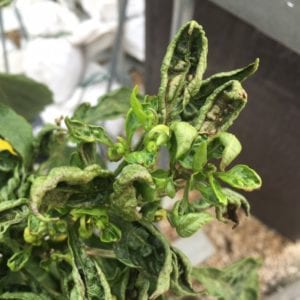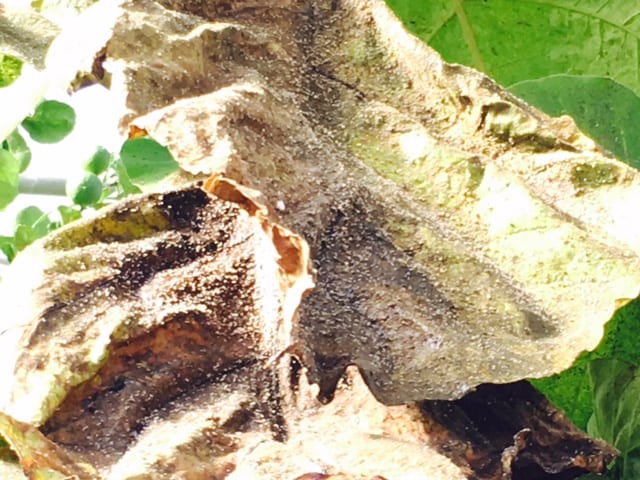Dry hot weather brings on the spider mites; they just love it! Know what else they love besides dry, hot weather… tomatoes, junipers, marigolds, and the list goes on and on. But what really turns these suckers on is seeing a plant that is in distress. That’s when spider mites really come running! Today we’ll talk about how to identify, prevent, and treat spider mites.
What are Spider Mites?
Spider mites are teeny-tiny insects (relatives of ticks and spiders) that suck the life out of plants rendering them useless. They love hot, dry weather, and are particularly fond of plants that have been neglected, are stressed (under-watered), and are in poor health. However, they can attack healthy plants too.
Plants Commonly Attacked by Spider Mites
Spider Mites love to attack the following plants, but they can go after just about anything when the right conditions present themselves.
- Tomatoes
- Junipers
- Marigolds
- Rosemary
- Houseplants
- Strawberries
- Any plant in distress or poor health
(Be sure to keep up with your tomato maintenance: watering, fertilizing, etc… spider mites love to atack tomatoes when the heat rolls in.)
Identifying Spider Mites and Spider Mites Damage
What you will usually see if you have spider mites is dusty, discolored foliage, or brown, curled leaves with yellow specks. If you have an extreme infestation, webbing across the foliage could be visible. Spider mites like to hide under the leaves of your plants (like most insects), so be sure you are looking under there when searching for the pests.
- Test for clear identification of spider mites by holding a plain, white sheet of paper under the plant. Shake, or thump the plant over the paper. Look for tiny red/brown spider mites that will be visible against the white paper. They will most likely be slowly scurrying about.

(What a sad sight! This milkweed has succumbed to spider mites. Spider Mites can take over a plant and suck its juices dry.)
Preventing Spider Mites
The #1 way to prevent spider mites from attacking is to make sure you are offering your plants every possible health advantage. Giving your plants adequate water, fertilizer, proper planting/spacing, proper light requirement, proper air circulation, and tender loving care will go a long way in preventing spider mites in the first place.
(Making sure your plants are watered, especially through prolonged drought periods can help to prevent spider mites.)
Treating Spider Mites
Spider mite infestations can quickly get out of control, so be diligent in the garden keeping plants adequately watered, especially in times of prolonged drought.
- Ornamental treatment: Systemic insecticides can eradicate spider mites and are the most effective, but they are unsuitable for edibles or gardens that host pollinators. Be sure you only spray your plants in the morning or late evening so you don’t risk any chemicals burning your plants in the heat of the day.
- Edibles treatment: Opt for Captain Jack’s Spinosad II, Pyrethrin, or certain formulas of Permethrin (approved for edibles). Seaweed, garlic sprays or Neem oil can be used as a repellant on new plants, especially when sprayed under the leaves. Again, spraying in cooler temperatures of the morning is advised as even organic sprays can burn plants when it is hot outside. Also, try to remove as much of the infected growth as you can.
- When an infestation is too great (webbing, plant looks like death) it’s time to throw in the towel and pull up and discard the plant into the trash. No composting! Chalk it up to a learning experience and make plans to pay more attention to your plants next time.

(Spinosad can help treat spider mites before an infestation gets too great.)
When in doubt about what’s “bugging” your plants, head on in to Rainbow Gardens with pictures of your plants (take multiple, clear-focused pictures at different views for best diagnosis) and let us see the problem firsthand so we can make sure you are getting the best treatment for your issue.
~The Happy Gardener




I like the lesson about red spider
The thump tests works for some’ but was never helpful until damage to tthe plant was asvanced.plant was far along. The first sign for me is yellow discoloration on lower leaves. The yelllow is a kind of bright gold. Then I begin to see black circles on the leaves which are joined by brown specks as theirsy bitsy spider moves up the plant. The underside of leaves may develop white webbing’ followed by the leaves turning all light brown. I hope this helps you know what you’re dealing with. For your sake I hope these are not spider mites.